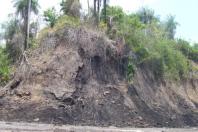Oil shale veteran confident industry will develop ‘sooner rather than later’ (Colorado)
Oil shale veteran confident industry will develop ‘sooner rather than later’
Post Independent (Grand Junction, Colorado).
Mike McKibbin, Nov 23, 2013
The subject of oil shale usually brings up a range of reactions and emotions among longtime area residents of western Garfield County.
The long-sought-after petroleum product is infamous for its long-held promise of economic benefits, high-paying jobs and what sounds like an almost non-ending supply to meet America’s growing energy needs.
But while that reality has proved elusive for centuries, some, such as Glenn Vawter, executive director of the National Oil Shale Association, are ever optimistic. The nonprofit group promotes factual information about oil shale.
Vawter started working in the oil shale industry in the 1960s and told a small crowd of students and others at Colorado Mountain College in Rifle on Thursday, Nov. 14, that despite the ups and downs the industry has gone through, he still thinks the resource will be developed “sooner rather than later.”
“I firmly believe we will some day see oil shale become a reality, and 75 percent of the world’s oil shale is in the U.S.,” Vawter said. “It’s already been produced commercially for decades in Brazil, Estonia and China.”
Boom and bust provides proven technology
A third generation West Slope resident, Vawter graduated from the Colorado School of Mines in 1960 and worked for several oil shale projects, including the TOSCO project in Garfield County. That project produced 200,000 barrels of shale oil, he said. The industry quickly abandoned the area when Exxon mothballed the Colony project outside Parachute in May 1982.
But the advancements made in the 1970s and 1980s at projects such as the Paraho Corp. project and Anvil Points outside Rifle are also part of the reason Vawter is optimistic about the future of the industry. The technology developed by Paraho is now being used in Australia, Vawter said.
The underground mining processes used by companies such as Unocal, which produced 10,000 barrels of shale oil a day during its limited operation, totaled five million barrels and was proven feasible, Vawter said.
The in situ, or in place, process that companies are now developing has the advantage of no mining, Vawter said.
Currently, research, design and development projects on Bureau of Land Management leases are underway by American Shale Oil, ExxonMobil and Natural Soda in western Garfield and Rio Blanco counties, along with Red Leaf Resources and Enefit American Oil in Utah.
“It was discouraging that Shell recently announced they were pulling out,” Vawter said. “But Red Leaf plans to start commercial production of up to 10,000 barrels a day in Utah next year. There’s a lot going on over there in Utah. They have policies that are more welcoming to energy and oil shale industries.”
Enefit has operated shale oil projects in Estonia for decades, Vawter pointed out, with a proven technology.
And Vawter pointed to a recent U.S. Geological Survey estimate of 4.3 trillion barrels of shale oil in Colorado, Wyoming and Utah. Of that, Vawter said up to 1.14 billion barrels are now considered recoverable. That is up to six times more than the total oil reserves in Saudi Arabia and significantly more than known U.S. conventional oil resources.
“There are places in the Piceance Basin that are estimated to have one million barrels in just one acre,” Vawter said. “The Piceance Basin could have up to 152 trillion barrels.”
Water used in the oil shale process has often been cited by opponents as a large hurdle, Vawter said, but current processes for a 1.5 million barrel per day project would require just 2 to 3 percent of an estimated 8 million acre feet per year of water in the Colorado River.
“That’s not an insignificant amount, but it’s far less than some still believe,” he said.
Companies will not invest money in a commercial project that has a negative energy return on investment, or the ratio of energy produced compared to energy needed to produce a resource, Vawter added. Several studies have shown that oil shale processing produces excess energy, he said.
“So we have so much experience in this industry,” Vawter stated. “We have a lot more information than people believe that can help move things forward.”
countering perceptions, flip flop policies
Overcoming the negative public perception that lingers from the bust of the 1980s is an obstacle, Vawter said.
“The reason the last oil shale boom happened was because the [federal] government threw money at it,” he said. “The bust happened when they withdrew that money and the price of oil dropped to $10 to $15 a barrel.”
And Vawter said it is important to distinguish between oil that’s now being produced from shale rock formations and shale oil.
“You hear a lot of news about all the drilling and fracturing going on in shale rock formations,” he said. “They kind of stole our name.”
Vawter said a more accurate name for oil from shale rock formations is “tight oil” or “liquid-rich shale.” Oil shale containing kerogen, which requires heating to produce shale oil, is what he and his organization focus on, he added.
A consistent federal energy policy is needed to ensure the oil shale industry can develop commercial projects, Vawter said.
“What we’ve had is flip flops going all the way back to, really, the 1910s,” he added.
Last year, the 2005 energy policy act was revised to dramatically reduce the acres of federal land available for commercial projects, Vawter said.
“The most attractive oil shale resource is on federal lands,” he stated.
Current leases can still be expanded to 5,120-acre commercial leases, Vawter noted.
And the requirement to prove a commercial process can work on a federal lease is “too restrictive,” he added.
But Vawter remains convinced the industry will one day flourish.
“Oil prices like we have now of around $80 to $90 a barrel are certainly a good incentive to move forward,” Vawter said. “Ten years ago, if you would have suggested a company drill into shale rock for liquid oil, it would not have been economical. Now it is.”
http://www.postindependent.com/news/rifle/8969934-113/oil-shale-vawter-barrels


